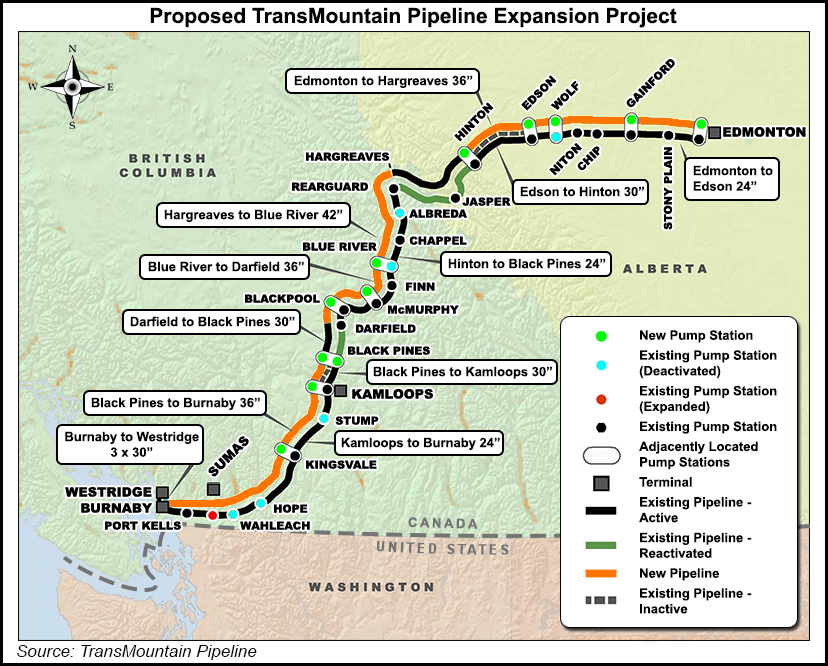Infrastructure | NGI All News Access
NEB Grants OK to Trans Mountain Oil Pipeline Expansion
The delayed Trans Mountain Pipeline oil pipe expansion advanced Friday after the National Energy Board (NEB) granted a revised approval to the growth outlet for overseas exports by Canada’s top natural gas user, Alberta thermal oilsands production.

The main change stiffens a whale protection condition of the first decision in 2016, to obey a verdict last August by the Canadian Federal Court of Appeal that overturned the initial NEB and national cabinet authorizations.
The new ruling came two days after a pro-pipeline rally on wheels at the Parliament Buildings by a convoy of about 150 oilfield trucks driven 2,200 miles east to Ottawa from Alberta. Ontario and Atlantic Canadian supporters swelled the traffic.
However, the parade won no promises of rapid action from the Liberal government, which bought Trans Mountain from Kinder Morgan Canada last year for C$4.5 billion ($3.4 billion) after native and environmental protests blocked Kinder’s version of the expansion.
Liberal leaders including Prime Minister Justin Trudeau vowed to avoid repeating the court setback three months after the takeover by cutting no corners on project approval requirements.
The NEB ruling is the first of three hurdles to clear before C$9 billion ($6.8 billion) in construction begins on nearly tripling capacity to 890,000 b/d on the 1,147-kilometer (688-mile) pipeline to Vancouver Harbor from Edmonton.
Next comes work by federal cabinet representatives on satisfying requirements set by the appeal court for consulting and accommodating interests of native communities along the line across Alberta and British Columbia.
The aboriginal relations job is underway. More than 60 officials, guided by retired Supreme Court judge Frank Iacobucci, are following an agenda that sets a 90-day target for finishing consultations with 117 native groups along Trans Mountain route.
An additional, complex proceeding before the NEB comes after completion of the native relations exercise enables the cabinet to give the green light for construction by ratifying the board approval and its 156 conditions.
Detailed route reviews and hearings are to follow. Construction only may begin after the pipeline acquires land rights, obtains NEB approval for the precise design and deposits plans at title registries.
Just days ago the Alberta government committed to leasing 4,400 railway tank cars as a three-year substitute for delayed oil pipeline projects, which included Trans Mountain,TransCanada Corp.’s Keystone XL and Enbridge Inc.’s Line 3 replacement.
On the eve of the appellate court setback last August, the procedure was completed for 72% of the Trans Mountain detailed route. Multiple objections remain unresolved in BC, where a forecast tanker traffic increase to 34 ships/month from five raises fears of spills and harm to an already endangered killer whale population.
The NEB’s revised project approval acknowledges that the federal cabinet and courts face persistent conflict among economic, environmental and native interests in deciding whether to accept the conditional regulatory finding in favor of construction.
“The benefits of the project are considerable, including increased access to diverse markets for Canadian oil; jobs created across Canada; the development of capacity of local and Indigenous individuals, communities, and businesses; direct spending on pipeline materials in Canada; and considerable revenues to various levels of government,” NEB said.
However, the board warned, “The project and its related marine shipping carries risks. Its burdens include the significant adverse effects that are likely to be caused by project-related marine shipping on the Southern resident killer whale and Indigenous cultural use associated with the Southern resident killer whale.”
Project opponents claim NEB and federal cabinet approvals remain liable to further appeals to the courts. The revised Trans Mountain ruling includes hotly disputed decisions such as rejection of environmentalist demands to extend tanker policing beyond Canada’s 12-mile territorial limit across the 200-mile coastal economic zone in maritime treaties.
© 2024 Natural Gas Intelligence. All rights reserved.
ISSN © 2577-9877 | ISSN © 2158-8023 |
